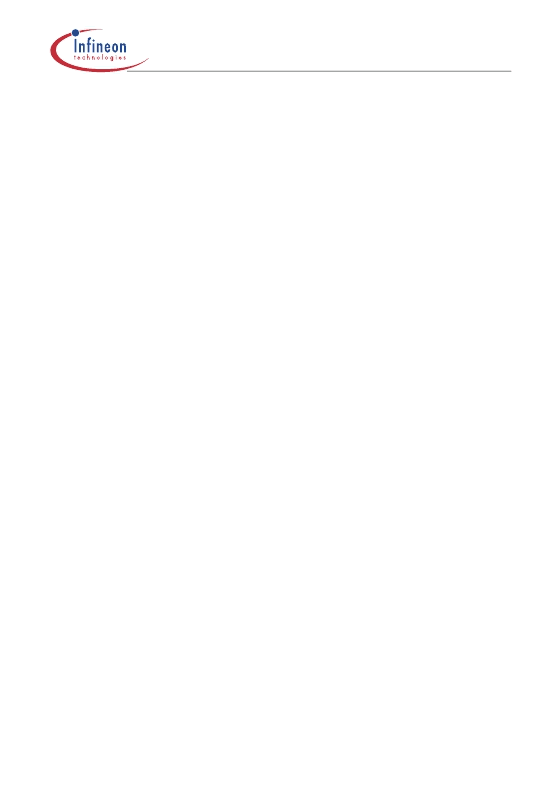- 您現(xiàn)在的位置:買賣IC網 > PDF目錄384032 > TUA6034 (INFINEON TECHNOLOGIES AG) 3-Band Digital TV / Set-Top-Box Tuner IC PDF資料下載
參數(shù)資料
| 型號: | TUA6034 |
| 廠商: | INFINEON TECHNOLOGIES AG |
| 英文描述: | 3-Band Digital TV / Set-Top-Box Tuner IC |
| 中文描述: | 3波段數(shù)字電視/設置機頂盒調諧器IC |
| 文件頁數(shù): | 45/61頁 |
| 文件大小: | 1281K |
| 代理商: | TUA6034 |
第1頁第2頁第3頁第4頁第5頁第6頁第7頁第8頁第9頁第10頁第11頁第12頁第13頁第14頁第15頁第16頁第17頁第18頁第19頁第20頁第21頁第22頁第23頁第24頁第25頁第26頁第27頁第28頁第29頁第30頁第31頁第32頁第33頁第34頁第35頁第36頁第37頁第38頁第39頁第40頁第41頁第42頁第43頁第44頁當前第45頁第46頁第47頁第48頁第49頁第50頁第51頁第52頁第53頁第54頁第55頁第56頁第57頁第58頁第59頁第60頁第61頁

Specification
45
V 2.5, 2004-04-28
TUA6034, TUA6036
Reference
10)Limits are related to the tank circuit used in the application board (see Chapter 3 on page 27). Frequency bands
may be adjusted by the choice of external components.
11)The frequency shift is defined as a change in oscillator frequency when the supply voltage varies from
V
= 5 to 4.75 V (4.5 V) or from V
CC
= 5 to 5.25 V (5.5 V). The oscillator is free running during this
measurement.
12)The frequency drift is defined as a change in oscillator frequency if the ambient temperature varies from T
A
=
25 to 50 °C or from T
A
= 25 to 0 °C. The oscillator is free running during this measurement.
13)The switch-on drift is defined as a change in oscillator frequency between 5 s and 15 min after switch-on. The
oscillator is free running during this measurement.
14)see Figure 8 Application Circuit for DVB-T on page 28.
15)see Figure 7 Application Circuit for ATSC on page 27.
16)The supply ripple susceptibility is measured in the application board (see Chapter 3 on page 27), using a
spectrum analyser connected to the IF output. An unmodulated RF signal is applied to the test board RF input.
A sinewave signal with a frequency of 500 kHz is superposed onto the supply voltage (see 4.5.8 on page 58).
The amplitude of this ripple is adjusted to bring the 500 kHz sidebands around the IF carrier to a level of 53.5
dBc referred to the carrier.
17)This is the level of divider interferences close to the IF frequency. For example channel S3: f
= 158.15 MHz,
1/4 f
OSC
= 39.5375 MHz. Divider interference is measured with the application board (see Chapter 3 on page
27).
(i.e. not connected to any load or cable). The MIDIN and HIGHIN inputs are connected to a hybrid. The
measured level of divider interference are influenced by layout, grounding and port decoupling. The
measurement results between various applications and the reference board could vary as much as 10 dB.
18)Crystal oscillator interference means the 4 MHz sidebands caused by the crystal oscillator. The rejection has
to be greater than 60 dB for an IF output of 100 dBμV.
19)The reference frequency rejection is the level of reference frequency sidebands (e.g. 62.5 kHz) related to the
carrier. The rejection has to be greater than 60 dB for an IF output of 100 dBμV.
相關PDF資料 |
PDF描述 |
|---|---|
| TUA6036 | 3-Band Digital TV / Set-Top-Box Tuner IC |
| TUA6036-T | 3-Band Digital TV / Set-Top-Box Tuner IC |
| TVP3026-135 | Video Interface PALETTE Exract(組合像素模式視頻接口調色器) |
| TVP3026-175 | Video Interface PALETTE Exract(組合像素模式視頻接口調色器) |
| TVP3026-175M | Video Interface PALETTE Exract(組合像素模式視頻接口調色器) |
相關代理商/技術參數(shù) |
參數(shù)描述 |
|---|---|
| TUA6034_06 | 制造商:INFINEON 制造商全稱:Infineon Technologies AG 功能描述:3-Band Digital TV / Set-Top-Box Tuner IC TAIFUN |
| TUA6034DEMOBOARD | 制造商:Infineon Technologies AG 功能描述: |
| TUA6034-T | 制造商:INFINEON 制造商全稱:Infineon Technologies AG 功能描述:3-Band Digital TV / Set-Top-Box Tuner IC TAIFUN |
| TUA6034TCUMA1 | 制造商:Infineon Technologies AG 功能描述:Tuners PAL/NTSC 863.25MHz 38-Pin TSSOP 制造商:Infineon Technologies AG 功能描述:IC MIXER/OSC/PLL DIGITAL TSSOP38 |
| TUA6034-V | 制造商:INFINEON 制造商全稱:Infineon Technologies AG 功能描述:3-Band Digital TV / Set-Top-Box Tuner IC |
發(fā)布緊急采購,3分鐘左右您將得到回復。